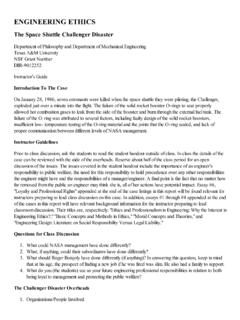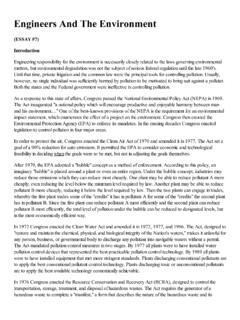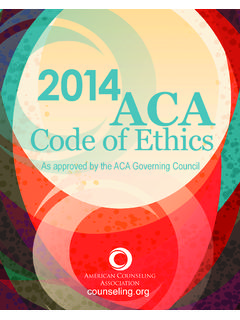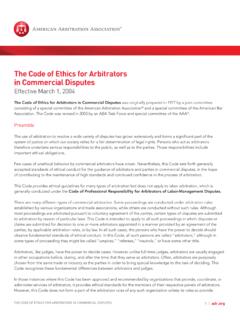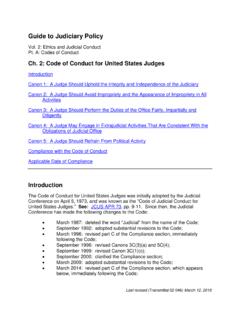Transcription of ENGINEERING ETHICS
1 ENGINEERING ETHICS . The Kansas City Hyatt Regency Walkways Collapse Department of Philosophy and Department of Mechanical ENGINEERING Texas A&M University NSF Grant Number DIR-9012252. Negligence And The Professional "Debate" Over Responsibility For Design Instructor's Guide - Introduction To The Case On July 17, 1981, the Hyatt Regency Hotel in Kansas City, Missouri, held a videotaped tea-dance party in their atrium lobby. With many party-goers standing and dancing on the suspended walkways, connections supporting the ceiling rods that held up the second and fourth-floor walkways across the atrium failed, and both walkways collapsed onto the crowded first-floor atrium below. The fourth-floor walkway collapsed onto the second-floor walkway, while the offset third-floor walkway remained intact. As the United States' most devastating structural failure, in terms of loss of life and injuries, the Kansas City Hyatt Regency walkways collapse left 114 dead and in excess of 200 injured.
2 In addition, millions of dollars in costs resulted from the collapse, and thousands of lives were adversely affected. The hotel had only been in operation for approximately one year at the time of the walkways collapse, and the ensuing investigation of the accident revealed some unsettling facts: During January and February, 1979, the design of the hanger rod connections was changed in a series of events and disputed communications between the fabricator (Havens Steel Company) and the ENGINEERING design team ( International, Inc., a professional ENGINEERING firm). The fabricator changed the design from a one-rod to a two-rod system to simplify the assembly task, doubling the load on the connector, which ultimately resulted in the walkways The fabricator, in sworn testimony before the administrative judicial hearings after the accident, claimed that his company (Havens) telephoned the ENGINEERING firm ( ) for change approval.
3 Denied ever receiving such a call from On October 14, 1979 (more than one year before the walkways collapsed), while the hotel was still under construction, more than 2700 square feet of the atrium roof collapsed because one of the roof connections at the north end of the atrium In testimony, stated that on three separate occasions they requested on-site project representation during the construction phase; however, these requests were not acted on by the owner (Crown Center Redevelopment Corporation), due to additional costs of providing on-site Even as originally designed, the walkways were barely capable of holding up the expected load, and would have failed to meet the requirements of the Kansas City Building Due to evidence supplied at the Hearings, a number of principals involved lost their ENGINEERING licenses, a number of firms went bankrupt, and many expensive legal suits were settled out of court.
4 The case serves as an excellent example of the importance of meeting professional responsibilities, and what the consequences are for professionals who fail to meet those responsibilities. This case is particularly serviceable for use in structural design, statics and materials classes, although it is also useful as a general overview of consequences for professional actions. The Hyatt Regency Walkways Collapse provides a vivid example of the importance of accuracy and detail in ENGINEERING design and shop drawings (particularly regarding revisions), and the costly consequences of negligence in this realm. For purposes of this case study, we assume that the disputed telephone call was made by the fabrication firm, and that the ENGINEERING firm did give verbal approval for the fatal design change. Students are, however, encouraged to view the case reversing these assumptions.
5 Guidelines For Presentation 1) Read student handout for a detailed description of the case. 2) At the class preceding case discussion, distribute student handouts: The Kansas City Hyatt Regency Walkways Collapse, which includes literature on negligence and the professional "debate" over responsibility for design, and an annotated bibliography. Have students come to the follow-up discussion class prepared to address the Kansas City Hyatt Regency Walkways Collapse in light of the ethical issues raised in the student handout. 3) Show Hyatt Regency Walkways Collapse segment of the "To Engineer is Human," video. Discuss with students the five overheads: 1. The Hyatt Regency Walkways Collapse Cast of Characters 2. Hanger Rod Details Original Design and As Built 3. Chronology of the Hyatt Regency Walkways Collapse (four pages). 4. ASME code of ETHICS of Engineers; and 5.
6 IEEE code of ETHICS . Ask students some of the following questions: Who is ultimately responsible for the fatal design flaw? Why? Does the disputed telephone call matter to the outcome of the case? Why or why not? What is the responsibility of a licensed professional engineer who affixes his/her seal to fabrication drawings? In terms of meeting building codes, what are the responsibilities of the engineer? The fabricator? The owner? What measures can professional societies take to ensure that catastrophes such as the Hyatt Regency Walkways Collapse do not occur? Do you agree with the findings that the principal engineers involved should have been subject to discipline for gross negligence in the practice of ENGINEERING ? Should they have lost their licenses, temporarily or permanently? Was it fair that , as a company, was held liable for gross negligence and ENGINEERING incompetence?
7 Why or why not? 4) End the discussion with Overhead 6), Hyatt Regency Walkways Collapse: Ethical Issues of the Case. Discuss the ethical questions raised by the case: what are the professional responsibilities of the engineers, fabricators, and hotel contractors? How can professionals protect themselves, and the public, from the gross negligence of an incompetent few? What are the implications of this case in terms of state-by-state licensing procedures? For a detailed discussion on these issues, see essay #5, "Negligence, Risk, and the Professional Debate Over the Responsibility for Design," appended at the end of the cases in the report. In addition, essays #1 through #4. appended at the end of the case listings in this report will have relevant background information for the instructor preparing to lead classroom discussion. Their titles are, respectively: " ETHICS and Professionalism in ENGINEERING : Why the Interest in ENGINEERING ETHICS ?
8 ;" "Basic Concepts and Methods in ETHICS ;" "Moral Concepts and Theories," and " ENGINEERING Design: Literature on Social Responsibility Versus Legal Liability.". Recommended Overheads For Use In Classroom Discussion 1) The Hyatt Regency Walkways Collapse Cast of Characters 2) Hanger Rod Details Original Design and As Built 3) Chronology of the Hyatt Regency Walkways Collapse 4) ASME code of ETHICS of Engineers 5) IEEE code of ETHICS 6) Hyatt Regency Walkways Collapse: Ethical Issues Of The Case Notes 1. Missouri Board for Architects, Professional Engineers and Land Surveyors vs. Daniel M. Duncan, Jack D. Gillum and International, Inc., before the Administrative Hearing Commission, State of Missouri, Case No. AR840239, Statement of the Case, Findings of Fact, Conclusions of Law and Decision rendered by Judge James B. Deutsch, November 14, 1985, pp. 54-63. Case No.
9 AR840239. hereinafter referred to as Administrative Hearing Commission. 2. Administrative Hearing Commission, pp. 63-66. 3. Administrative Hearing Commission, p. 384. 4. Administrative Hearing Commission, pp. 12-13. 5. Administrative Hearing Commission, pp. 423-425. Copy of Administrative Hearing Commission: pdf version Word version Note that both of these were scanned from a every poor copy of the document. Sorry, but you get what you paid for. Hyatt Regency Walkways Collapse Overheads 1. The Hyatt Regency Walkways Collapse Cast of Characters 2. Hanger Rod Details Original Design and As Built 3. Chronology of the Hyatt Regency Walkways Collapse (4 pages). 4. ASME code of ETHICS of Engineers 5. IEEE code of ETHICS 6. Hyatt Regency Walkways Collapse: Ethical Issues Of The Case The Hyatt Regency Walkways Collapse Cast Of Characters In 1976, as owner, Crown Center Redevelopment Corporation - commenced a project to design and build a Hyatt Regency Hotel in Kansas City, Missouri, and on April 4, 1978, Crown entered into a standard contract with International, Inc.
10 Professional Consulting Firm of Structural Engineers (1980 formerly called Jack D. Gillum & Associates, Ltd. changed name to May 5, 1983). Principals Jack D. Gillum , structural ENGINEERING state licensed since February 26, 1968. Daniel M. Duncan , structural ENGINEERING state licensed since February 27, 1979. PBNDML Architects, Planners, Inc. Architect. agreed to provide, "all structural ENGINEERING services for a 750-room hotel projected located at 2345. McGee Street, Kansas City, Missouri.". On or about December 19, 1978, Eldridge Construction Company, the general contractor on the Hyatt project, entered into a subcontract with Havens Steel Company Professional Fabricator who agreed to fabricate and erect the atrium steel for the Hyatt project. Chronology Of The Hyatt Regency Walkways Collapse Early 1976: Crown Center Redevelopment Corporation (owner) commences project to design and build a Hyatt Regency Hotel in Kansas City, Missouri.


